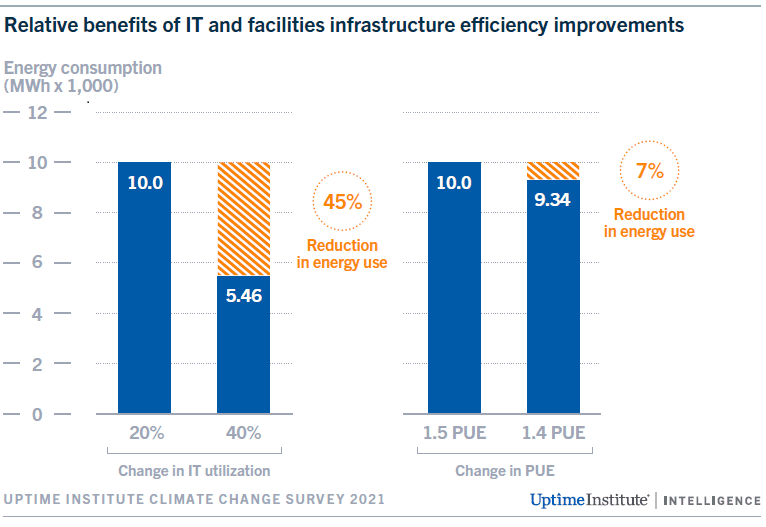Energy consumed by data centers can significantly affect the operating costs and consequential environmental impacts like greenhouse gas (GHG) emissions. The data center operations teams must develop a comprehensive plan for measuring energy consumption as an energy management program is an integral part of a sustainability strategy. Here is the summary of the report ‘Reducing the energy footprint’ by Uptime Institute that will guide the operations team to formulate an effective energy management plan.
The first objective of energy management must be minimizing energy usage by conserving energy and increasing efficiency by delivering maximum IT work per unit of energy consumed in the data center. Improving IT equipment utilization efficiency significantly impacts energy consumption and can be measured by power use effectiveness (PUE). IT efficiency objectives should be given due priority and managers can work with the IT operations team for setting improvement goals for equipment utilization. By this, data centers can reduce their operational costs and environmental impact and increase productivity for each unit of energy consumed.
The figure below shows that by doubling IT equipment utilization, it is possible to remove roughly half the server or storage equipment.

Analyzing the energy-related data can help the operations teams to reduce the energy consumption for a given quantity of IT work. Tracking the measurements and metrics should be done regularly as part of routine business processes and operations. Using renewable electricity can accelerate environmental benefits, especially in the reduction of GHG emissions.
Guidelines for an effective energy management plan
- Adopt conservation and efficiency measures within the constraints of resiliency and reliability requirements to minimize energy consumption.
- Optimize facilities and IT systems to minimize energy consumption.
- Set an energy conservation goal (in MWh) of energy conserved over a defined 12-month period.
- Promote innovation through incentivizing to increase operational efficiency. Integrate energy generated from renewable sources.
- Collect and track operating metrics and inventories for monitoring system performance and efficiency.
- A consistent set of metrics and goals must be applied across all IT operations and services which includes colocation and cloud providers.
- The amount of renewable energy supplied directly to the operating facilities must be increased keeping in mind that with current technology, it is not possible to reliably operate a data center on 100% renewable energy until all generation capacity within a grid zone is zero emissions.
- Set goals of renewable energy usage and procurement as a percentage of the actual and/or matched electricity consumption that is achievable by a certain date.
- Collaborate with the financial, procurement, and legal teams to set admissible terms, conditions, and costs of purchasing renewable energy.
- Associate with energy retailers, utilities, project developers, and consultants for identifying and developing economically acceptable opportunities for obtaining renewable energy and renewable energy certificates.
- Satisfy customers with a proper carbon reduction strategy to improve energy efficiency and increase the use of renewable energy.
- The management team must be committed to achieving the goals set for energy conservation, efficiency, and renewable energy procurement.








